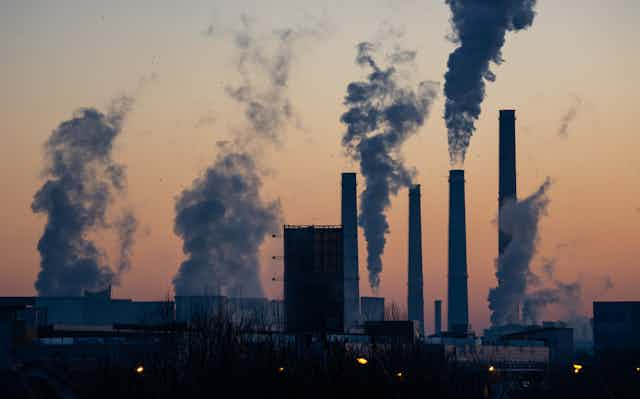As one of the world’s largest emitters of greenhouse gases and the fourth-largest coal producer, Indonesia must continue pursuing its efforts to create a domestic carbon market. This requires a series of actions to create economic value from carbon-reduction activities.
The foundations – and most importantly the political will – have been laid out.
First, Indonesia has signed Presidential Regulation Number 98/2021 on Carbon Pricing. This is a significant policy for implementing a market-based mechanism to reduce emissions.
Second, Indonesia has signed up to several pledges at the UN climate talks (COP26). These include the Global Deforestation Pledge, the Global Methane Pledge and the Global Coal to Clean Power Transition.
In the lead-up to Indonesia’s G20 presidency next year, we are also hearing the country has committed to reaching net-zero emissions by 2060 or sooner.
Third, we’re seeing strong green policy signals. An example is the revised car emissions tax policies, which will apply much lower taxes for low-emission vehicles and zero tax on electric vehicles.
Indonesia is also set to implement a carbon tax in the electricity sector, followed by another emissions trading mechanism and emissions cap (limitation) policy.
These signals could accelerate Indonesia’s transition from coal to renewable energy if the government continues to strengthen its emission-related policies.
However, to create a successful domestic carbon market, Indonesia needs to focus on at least three things.
1. Carbon trading should support energy transition program
Developing a carbon market in the electricity sector should not just provide further permission to emit. It should actively assist the government to phase out coal and fund low-carbon technology.
Currently, the carbon-trading scheme in Indonesia operates under a voluntary mechanism. Some 80 coal-fired power plants with capacity of more than 20,000MW aim to join the carbon market this year. This is about 55% of the country’s overall coal-fired power capacity (36,000MW).
The aim of the voluntary carbon trading mechanism is to introduce the emission trading scheme (ETS) as well as carbon offset mechanism (an emission-reduction program to compensate for emissions that occur in other places) in the country’s energy sector.
The limit or “the cap” will be set on the carbon intensity (number of grams of CO₂ per unit of power production – usually per kilowatt hour) rather than an absolute cap on emissions (total emissions produced).
Under the recently established Presidential Regulation No. 98/2021 on Carbon Pricing, the government will issue emission permits. Companies buy these from the government for the amount of greenhouse gases they are permitted to emit.
If those entities fail to report their emissions and their climate change mitigation actions, a number of administrative sanctions will be applied. These range from written warning and administrative fines up to suspension and revocation of the permit.
However, with the power sector accounting for up to 30% of the country’s total energy-related emissions, Indonesia requires a legislated cap on emissions – where the government determines the cap.
The issuing of permits would need to be accompanied by strict eligibility requirements to avoid permit oversupply and lack of corporate action in low-carbon transitions.
This policy should be coupled with mandatory compliance with the carbon trading mechanism to accelerate the transition away from coal.
Furthermore, the mandatory carbon pricing program must be followed by phasing out fossil fuel subsidies. In 2016-2017, the government budgeted over US$0.7 billion (Rp9.9 trillion) per year to control the cost of electricity from coal-fired power production.
The government should reallocate the subsidy budget to support Indonesia’s coal transition project – such as fiscal incentives for renewable energy tariffs.
Unless fossil fuel subsidies are reduced, renewable energy as the primary object of the transition program will remain less competitive against fossil fuels.
2. Maximise the carbon price
Another thing to be addressed is the low current carbon price imposed in the coal phase-out scheme. The price is pegged at US$2.10 per tonne of CO₂ in Indonesia.
A recent World Bank study mentioned a range of US$40-80 per tonne of CO₂ to keep global temperature rises below 2°C.
Therefore, to reach the 1.5°C target – as noted in the Glasgow Climate Pact – we need to impose a higher carbon price.
To be effective in reducing emissions, the carbon tax stipulated in Indonesia’s Tax Law must be maximised as more sectors become more involved in the carbon market and energy-efficiency technology becomes widely available.
3. Let’s focus on the goal to accelerate clean energy transition
In the long run, carbon trading will encourage investors to pay more attention to renewable energy deployment.
The idea is pretty simple: a carbon trading scheme creates an incentive across the economy to reduce emissions and invest in renewable energy.
Allowing carbon trading between entities in different sectors could increase the demand for renewable energy or other energy-efficient technologies.
When stimulating renewable energy technology development, it is equally important for the government to ensure greater ease of doing business in this area.
This includes providing incentives for building renewable energy infrastructure like smart grids, transmission and storage. Incentives and grants should be directed towards supporting research, deployment and commercialisation of renewable energy and related technology.
Indonesia also cannot phase out coal plants effectively without solid project finance, technology transfers, skilled labour and adequate infrastructure such as power storage and transmission to accelerate the development of renewable energy.
The impacts of carbon-pricing mechanisms are significant as they ramp up energy-efficiency opportunities, support innovation and increase investment in clean technology.

